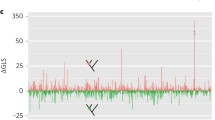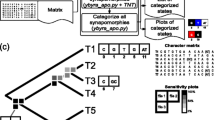Abstract
The ever-larger data matrices resulting from continuing improvements in DNA sequencing techniques require faster and more efficient methods of phylogenetic analysis. Here we explore a promising new method, parsimony jackknifing, by analyzing a matrix comprising 2538 sequences of the chloroplast generbcL. The sequences included cover a broad taxonomic range, from cyanobacteria to flowering plants. Several parsimony jackknife analyses were performed, both with and without branch-swapping and multiple random addition sequences: 1) including all positions; 2) including only first and second codon positions; 3) including only third positions; and 4) using only transversions. The best resolution was obtained using all positions. Removal of third positions or transitions led to massive loss of resolution, although using only transversions somewhat improved basal resolution. While branch-swapping improved both resolution and the support found for several groups, most of the groups could be recovered by faster simple analyses. Designed to eliminate groups poorly supported by the data, parsimony jackknifing recognizes 1400 groups on the basis of allrbcL positions. These include major taxa such as green plants, land plants, flowering plants, monocots and eudicots. We include appendices of supported angiosperm families, as well as larger groups.
Similar content being viewed by others
References
Albert, V. A., Williams, S. E., Chase M. W., 1992: Carnivorous plants: phylogeny and structural evolution. — Science257: 1491–1495.
—, 1994: Functional history andrbcL evidence for land plant phylogeny. — Ann. Missouri Bot. Gard.81: 534–567.
Alverson, W. S., Karol, K. G., Baum, D.A., Chase, M. W., Swensen, S. M., McCourt, R., Sytsma, K. J., 1998: Circumscription of theMalvales and relationship to otherRosidae: evidence fromrbcL sequence data. — Amer. J. Bot. (in press).
Anderberg, A. A., Ståhl, B., Källersjö, M., 1998: Phylogenetic interrelationships in thePrimulales inferred fromrbcL sequence data. — Pl. Syst. Evol.211: 93–102.
Backlund, A., Bremer, B., 1998: Phylogeny of theAsteridae s.str. based onrbcL sequences, with particular reference to theDipsacales. — Pl. Syst. Evol.207: 225–254.
Bayer, C., Chase, M. W., Fay, M. F., 1998:Muntingiaceae, a new family of dicotyledons with malvalean affinities. — Taxon47: 37–42.
Bremer, B., 1996: Phylogenetic studies withinRubiaceae and relationships to other families based on molecular data. — Opera Bot. Belg.7: 33–50.
Bremer, K., 1985: Summary of green plant phylogeny and classification. — Cladistics1: 369–385.
—, 1988: The limits of amino acid sequence data in angiosperm phylogenetic reconstruction. — Evolution42: 795–803.
—, 1994: Branch support and tree stability. — Cladistics10: 295–304.
Chase, M. W., Soltis, D. E., Olmstead, R. G., Morgan, D., Les, D. H., Mishler, B. D., Duvall, M. R., Price, R. Q., Hills, H. G., Qiu, Y.-L., Kron, K. A., Rettig, J. H., Conti, E., Palmer, J. D., Manhart, J. R., Sytsma, K. J., Michaels, H. J., Kress, W. J., Karol, K. G., Clark, W. D., Hedrén, M., Gaut, B. S., Jansen, R. K., Kim, K.-J., Wimpee, C. F., Smith, J. F., Furnier, G. R., Strauss, S. H., Xiang, Q.-Y., Plunkett, G. M., Soltis, P. S., Swensen S., Williams, S. E., Gadek, P. A., Quinn, C. J., Eguiarte, L. E., Golenberg, E., Learn, G. H., Jr.,Graham, S. W., Barrett, S. C. H., Dayanandan, S., Albert, V. A., 1993: Phylogenetics of seed plants: an analysis of nucleotide sequences from the plastid generbcL. — Ann. Missouri Bot. Gard.80: 528–580.
—, 1995a: Molecular phylogenetics ofLilianae. — InRudall, P. J., Cribb, P. J., Cutler, D. F., Humphries, C. J., (Eds): Monocotyledons: systematics and evolution, pp. 109–137. — Richmond: Royal Botanic Gardens, Kew.
—, 1995b: Monocot systematics: a combined analysis. — InRudall, P. J., Cribb, P. J., Cutler, D. F., Humphries, C. J., (Eds): Monocotyledons: systematics and evolution, pp. 685–730. — Richmond: Royal Botanic Gardens, Kew.
—, 1996: New circumscriptions and a new family of asparagoid lilies: genera formerly included inAnthericaceae. — Kew Bull.51: 667–680.
Conti, E., Litt, A., Sytsma, K. J., 1996: Circumscription ofMyrtales and their relationships to other rosids: evidence fromrbcL sequence data. — Amer. J. Bot.83: 221–233.
Cronquist, A., 1981: An integrated system of classification of flowering plants. — New York: Columbia University Press.
Dahlgren, R. M. T., Clifford, H. T., 1982: The monocotyledons: a comparative study. — London: Academic Press.
—, 1985: The families of the monocotyledons. — Berlin, Heidelberg, New York: Springer.
Doyle, J. A., Donoghue, M. J., Zimmer, E. A., 1994: Integration of morphological and ribosomal RNA data on the origin of angiosperms. — Ann. Missouri Bot. Gard.81: 419–450.
Duvall, M. R., Clegg, M. T., Chase, M. W., Clark, W. D., Kress, W. J., Hills, H. G., Eguiarte, L. E., Smith, J. F., Gaut, B. S., Zimmer, E. A., Learn, G. H. Jr., 1993: Phylogenetic hypotheses for the monocotyledons constructed fromrbcL sequence data. — Ann. Missouri Bot. Gard.80: 607–619.
Farris, J. S., 1988: Hennig86, version 1.5. Computer program and documentation. — Port Jefferson, New York.
—, 1996: ‘Jac. Version 4.4.’ — Stockholm: Swedish Museum of Natural History.
—, 1996: Parsimony jackknifing outperforms neighbor-joining. — Cladistics12: 99–124.
-Goloboff, P., Källersjö, M., Oxelman, B., 1998: Improving the bootstrap. — Cladistics (in press).
Fay, M. F., Swensen, S. M., Chase, M. W., 1997: Taxonomic affinities ofMedusagyne oppositifolia (Medusagynaceae). — Kew Bull.52: 111–120.
Felsenstein, J., 1985: Confidence limits on phylogenies: an approach using the bootstrap. — Evolution39: 783–791.
Fernando, E. S., Gadek, P. A., Crayn, D. M., Quinn, C. J., 1993: Rosid affinities ofSurianaceae: molecular evidence. — Molec. Phylogenet. Evol.2: 344–350.
—, 1995:Simaroubaceae, an artificial construct: evidence fromrbcL sequence variation. — Amer. J. Bot.82: 92–103.
Golenberg, E. M., Giannasi, D. E., Clegg, M. T., Smiley, C. J., Durbin, M., Henderson, D., Zurawski, G., 1990: Chloroplast DNA sequence from a mioceneMagnolia species. — Nature344: 656–658.
Goloboff, P., 1993: Pee-Wee and NONA. Computer programs and documentation. — New York.
Gustafsson, M. H. G., Bremer, K., 1997: The circumscription and systematic position ofCarpodetaceae. — Austral. Syst. Bot.10: 855–862.
—, 1996: Phylogeny of the Asterales sensu lato based onrbcL sequences with particular reference to theGoodeniaceae. — Pl. Syst. Evol.199: 217–242.
Hasebe, M., Wolf, P. G., Pryer, K. M., Ueda, K., Ito, M., Sano, R., Gastony, G. J., Yokoyama, J., Manhart, J. R., Murakami, N., Crane, E. H., Haufler, C. H., Hauk, W. D., 1995: Fern phylogeny based onrbcL nucleotide sequences. — Amer. Fern J.85: 134–181.
Huber H., 1969: Die Samenmerkmale und Verwandtschaftsverhältnisse derLiliiflorae. — Mitt. Bot. Staatssamml. München8: 219–538.
Jeffrey, C., 1982: Kingdoms, codes and classification. — Kew Bull.37: 403–416.
Källersjö, M., Farris, J. S., Kluge, A. G., Bult, C., 1992: Skewness and permutation. — Cladistics8: 275–287.
Kron, K. A., Chase, M. W., 1993: Systematics of theEricaceae, Empetraceae, Epacridaceae and related taxa based uponrbcL sequence data. — Ann. Missouri Bot. Gard.80: 735–741.
Kumar, S., Tamura, K., Nei, M., 1993: MEGA: molecular evolutionary genetic analysis. Computer program and documentation. — University Park: Pennsylvania State University.
Manhart, J. R., 1994: Phylogenetic analysis of green plantrbcL sequences. — Molec. Phylogenet. Evol.3: 114–127.
Mattox, K. R., Stewart, K. D., 1984: Classification of the green algae: a concept based on comparative cytology. — InIrvine, D. E. G., John, D., (Eds): The systematics of green algae, pp. 29–72. — London: Academic Press.
Mishler, B. D., Lewis, L. A., Buchheim, M. A., Renzaglia, K. S., Garbary, D. J., Delwiche, C. F., Zechman, F. W., Kantz, T. S., Chapman, R. L., 1994: Phylogenetic relationships of the ‘green algae’ and ‘bryophytes’. — Ann. Missouri Bot. Gard.81: 451–483.
Morgan, D. R., Soltis, D. E., 1993: Phylogenetic relationships among members ofSaxifragaceae sensu lato based onrbcL sequence data. — Ann. Missouri Bot. Gard.80: 631–660.
—, 1994: Systematic and evolutionary implications ofrbcL sequence variation inRosaceae. — Amer. J. Bot.81: 890–903.
Morton, C. M., Chase, M. W., Karol, K. G., 1997a: Taxonomic affinities ofPhysena (Physenaceae) andAsteropeia (Asteropeiaceae). — Bot. Rev.63: 231–239.
—, 1997b: A molecular evaluation of the monophyly of the orderEbenales based uponrbcL sequence data. — Syst. Bot.21: 567–586.
—, 1997c: Phylogenetic relationships ofLecythidaceae: a cladistic analysis usingrbcL sequences and morphological data. — Amer. J. Bot.84: 530–540.
Nixon, K. C., Crepet, W. L., Stevenson, D., Friis, E. M., 1994: A reevaluation of seed plant phylogeny. — Ann. Missouri Bot. Gard.81: 484–533.
Olmstead, R. G., Reeves, P. A., 1995: Evidence for the polyphyly of theScrophulariaceae based on chloroplastrbcL andndhF sequences. — Ann. Missouri Bot. Gard.82: 176–193.
—, 1993: A parsimony analysis of theAsteridae sensu lato based onrbcL sequences. — Ann. Missouri Bot. Gard.80: 700–722.
Plunkett, G. M., Soltis, D. E., Soltis, P. S., 1996: Higher level relationships ofApiales (Apiaceae andAraliaceae) based on phylogenetic analysis ofrbcL sequences. — Amer. J. Bot.83: 399–415.
Price, R. A., Palmer, J. D., 1993: Phylogenetic relationships of theGeraniaceae andGeraniales fromrbcL sequence comparisons. — Ann. Missouri Bot. Gard.80: 661–671.
Qiu, Y.-L., Chase, M. W., Les, D. H., Parks, C. R., 1993: Molecular phylogenetics of theMagnoliidae: cladistic analyses of nucleotide sequences of the plastid generbcL. — Ann. Missouri Bot. Gard.80: 587–606.
Rice K. A., Donoghue, M. J., Olmstead, R. G., 1997: Analyzing large date sets:rbcL 500 revisited. — Syst. Biol.46: 554–563.
Ritland, K., Clegg, M. T., 1987: Evolutionary analyses of plant DNA sequences. — Amer. Naturalist130: S74-S100.
Rodman, J. E., Price, R. A., Karol, K., Conti, E., Sytsma, K. J., Palmer, J. D., 1993: Nucleotide sequences of therbcL gene indicate monophyly of mustard oil plants. — Ann. Missouri Bot. Gard.80: 686–699.
Rudall, P. J., Cutler, D. F., 1995:Asparagales: a reappraisal. — InRudall, P. J., Cribb, P. J., Cutler, D. F., Humphries, C. J., (Eds): Monocotyledons: systematics and evolution, pp. 157–168. — Richmond: Royal Botanic Gardens, Kew.
—, 1996: Systematics ofXanthorrhoeaceae sensu lato: evidence for polyphyly. — Telopea6: 629–647.
Sanderson, M. J., 1989: Confidence limits on phylogenies: the bootstrap revisited. — Cladistics5: 113–129.
Savolainen, V., Spichiger, R., Manen, J.-F., 1997: Polyphyletism ofCelastrales deduced from a chloroplast noncoding DNA region. — Molec. Phylogenet. Evol.7: 145–157.
Sheahan, M. C., Chase, M. W., 1996: A phylogenetic analysis ofZygophyllaceae R. Br. based on morphological, anatomical andrbcL sequence data. — Bot. J. Linn. Soc.122: 279–300.
Smith, J. F., Kress, W. J., Zimmer, E. A., 1993: Phylogenetic analysis of theZingiberales based onrbcL sequences. — Ann. Missouri Bot. Gard.80: 620–630.
Swofford, D., 1993: PAUP, phylogenetic analysis using parsimony, version 3.1.1. — Champaign, Illinois: Illinois Natural History Survey.
Takhtajan, A. L., 1994: New families of the monocotyledons. — Bot. Zhurn.79: 65–66.
Wolf, P. G., 1995: Phylogenetic analyses ofrbcL and nuclear ribosomal RNA gene sequences inDennstaedtiaceae. — Amer. Fern J.85: 306–327.
Zurawski, G., Clegg, M. T., 1987: Evolution of higher-plant chloroplast DNA-coded genes: implications for structure-function and phylogenetic studies. — Ann. Rev. Pl. Physiol.38: 391–418.
Author information
Authors and Affiliations
Rights and permissions
About this article
Cite this article
Källersjö, M., Farris, J.S., Chase, M.W. et al. Simultaneous parsimony jackknife analysis of 2538rbcL DNA sequences reveals support for major clades of green plants, land plants, seed plants and flowering plants. Pl Syst Evol 213, 259–287 (1998). https://doi.org/10.1007/BF00985205
Received:
Revised:
Accepted:
Issue Date:
DOI: https://doi.org/10.1007/BF00985205




